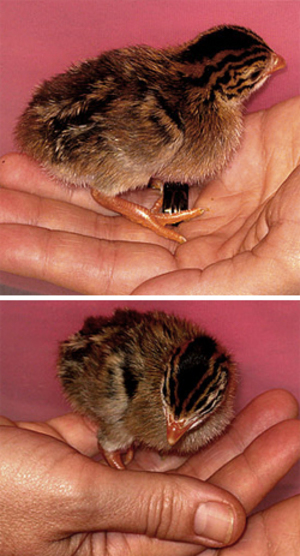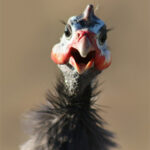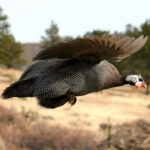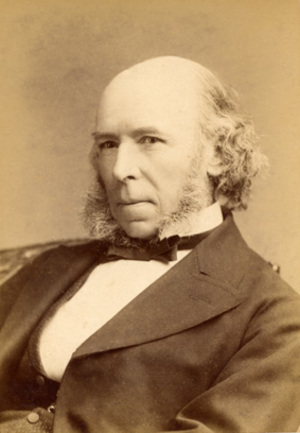Guinea fowl, originally native to Africa, are rapidly growing in popularity around the world. Perhaps nowhere is esteem for Guinea fowl increasing faster than in the United States. Little wonder. The Guinea fowl diet consists predominately of bugs, and one of their favorites is the ubiquitous, and sometimes deadly, tick. Guinea fowl also eat the seeds of weeds, thus thwarting their spread. Guinea fowl are used to keep barns free of mice, and they will warn of, drive off or kill snakes. Guinea fowl also make a superb alarm system. Guinea fowl will make quite the noisy raucous whenever any change occurs in their environment.
There are several varieties of Guinea fowl, but it is the helmeted Guinea fowl that has been domesticated and exported throughout the world. In the United States today, there are numerous commercial hatcheries and countless individuals selling Guinea fowl eggs, keets and adults. “Keets” are Guinea fowl offspring, and the term keet applies until they are about eight weeks of age. Guinea fowl are sometimes referred to as Guinea hens. Naturally, Guinea fowl are both hens (female) and cocks (male). Hence, the term Guinea hen is somewhat misleading.
The helmeted Guinea fowl is available in many colors and color combinations including pearl gray, royal purple, violet, bronze, slate, coral blue, lavender, copper, chocolate, white, buff and pied pearl gray. Photographs of Guinea fowl in all of the above colors and more are available for viewing at http://www.guineafowlinternational.org/colorchart/.
Helmeted Guinea fowl are now also available in two sizes. The originally domesticated variety of Guinea fowl weighs up to about 3½ pounds. Jumbo Guinea fowl weigh from 5-7 pounds. Jumbo Guinea fowl are available in the original pearl gray color pattern: white spots called “pearls” on a very dark gray background.
Guinea fowl, while capable of short flights and excellent gliding, are ground dwelling birds. They eat, breed, nest and lay their eggs on the ground. Except for females sitting on eggs, Guinea fowl prefer to roost in trees during the night. People who raise and keep Guinea fowl usually prefer that their birds roost in a coop. This keeps the birds dry, warmer and safe from predators such as owls, raccoons, skunks, cats and others, depending on the geographical location.
Guinea fowl are flocking birds. This is to say that they are most comfortable when there are others of their species around them. With this in mind, it is not advisable to have single Guinea fowl. Three or four Guinea fowl is an acceptable flock size and will make the birds more comfortable and content. No matter the size of the Guinea fowl flock, a pecking order will be established by the birds themselves. There will be one dominant bird, and one bird at the bottom of the order. All the others will find their status in between.
People who want to start keeping Guinea fowl can purchase their new birds in any of three ways.
1) As fertile eggs to be incubated and hatched.
2) As keets to be raised.
3) As adults.
Those new to keeping Guinea fowl should purchase keets when starting their flock. Keets are usually delivered when they are two or three days of age. Starting out with Guinea fowl keets avoids the time and expense of incubating the eggs for 26-28 days. Incubating Guinea fowl eggs is best left to those with the proper equipment and experience. Purchasing adult Guinea fowl also has disadvantages for the first-time Guinea fowl keeper. You’ll want to train your Guinea fowl, and this is most easily done starting when they are keets.
Essentially, there is one thing Guinea fowl keepers want to train their flock to do: come when called. Training Guinea fowl to come on command is invaluable during their lives. It allows the keeper to call the birds into the safety of the coop at night, and also allows the birds to be directed to specific places to drastically reduce the bug population. Guinea fowl are great pest controllers for organic gardens – or any garden, for that matter. If a Guinea fowl keeper has a bee, hornet or wasp problem, he or she need only get the Guinea fowl close to where the insects congregate. The Guinea fowl will do the rest.
Adult helmeted Guinea fowl are very tough animals. Like all animals, however, they require care and assistance to reach healthy maturity. Raising Guinea fowl keets is not at all difficult, but there are a few things that need to be done for the safety and health of the keets. Guinea fowl keets need warmth, shelter from drafts and predators, dryness, food and water.
The first few days of life, keets should be kept in a container with a temperature of about 100°F. A giant plastic tub with a small light bulb works fine. The water supply for the young keets needs to be lukewarm, and setup so that the keets cannot get into it and get wet or drown themselves. Feeding the Guinea fowl keets turkey starter with AMP is the most popular diet. Cover the bottom of the keets’ home with paper towels, and change them as needed. Gently handle the keets from the first day to get them used to you and other family members.
For complete information on how to successfully raise Guinea fowl keets, visit the Guinea Fowl International Association’s forum at: http://www.guineafowlinternational.org/forum/. Join the forum and you can ask specific questions and get knowledgeable responses quickly. It’s an invaluable resource for the Guinea fowl keeper!
If you’d like to see some great videos about keets growing up, visit: http://www.mymilescity.com/guinea/tv.html. At the bottom of the page are links to all the available videos. As the number of the episode gets higher, the keets are older, and ultimately mature. The videos are extremely well done, and besides being informative, they are quite entertaining.
Training the Guinea fowl to come when called is most often done using white proso millet. Guinea fowl love this inexpensive treat. Just make a call such as “here guinea, guinea, guinea” and sprinkle some millet on the ground. At first, their response is slow, but they quickly catch on and run to get their candy. The above linked videos actually show the progression of this process of training over time.
Guinea fowl are quickly becoming more popular largely because of the fact that they will quickly, safely rid an area of disease carrying ticks, as well as other insect pests. But as people learn that Guinea fowl are also entertaining, personable and family-friendly birds, they are also starting to fill a niche as family pets. When Guinea fowl keepers spend a lot of time with their birds, they become quite friendly and responsive.
Keeping Guinea fowl is not for everyone. They do tend to wander a bit, and some neighbors might not appreciate their insect removing skills in their yards. They also make quite a noise when they are disturbed about something like strangers, unknown animals or cars. Again, neighbors might not like hearing the Guinea fowl ‘alarm’ go off. Beekeepers should not raise Guinea fowl within ¼ mile of their hives. Guinea fowl keepers need a safe, enclosed home (coop) for their flock, and a fenced area is also very nice to have. Small coops can be purchased on line, and larger coops are relatively easy and inexpensive to build.
Guinea fowl are inexpensive to purchase and maintain, easy to raise to maturity, naturally perform some very worthwhile tasks around the homestead, and are a constant source of entertainment. They provide nutritious eggs during the spring and summer months and their colorful, patterned feathers are sought after by many artists. A small flock of Guinea fowl might be just what your home and family need. They certainly deserve a close look. I have a flock of 30 wonderful pearl gray Guinea fowl and there’s one thing I’ve learned for sure: I will always keep Guinea fowl on the property.





